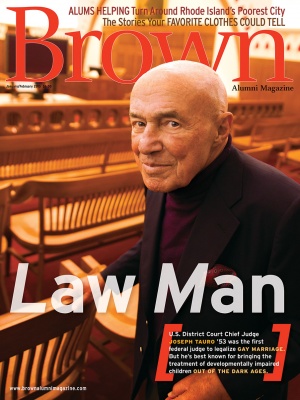For Emily Spivack ’01, it’s all about the clothes. Not in a fashionista, gotta-have-the-latest-look kind of way, but clothes as physical manifestations of memory, as the talismans from pivotal moments in our lives. Or, to put it in Spivack’s terms, clothes as “a cultural, historical, anthropological, and even therapeutic lens” through which to view the world. “Clothing,” she says, “has been a real jumping-off point for me.”
In In 2010, Spivack began soliciting clothing stories from friends, acquaintances, friends of friends, artists, and on craigslist. She then gathered sixty-seven of these into Worn Stories, published last fall. Among the personal tales were six by alums. “The clothes that protect us, that make us laugh, that serve as a uniform, that help us assert our identity or aspirations, that we wear to remember someone—in all of these are encoded the stories of our lives,” Spivack wrote in the book’s introduction. n Not surprisingly, Worn Stories became a New York Times best-seller.
Do you have a piece of clothing so special that you can’t throw it out? Let us know in the comments space below.—Leslie Weeden
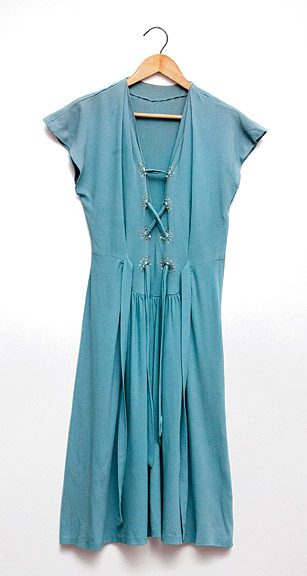
I was heartbroken, disoriented, devastated. My life felt torn in a way that was scary. I had been so bonded to him that with him gone and our bond broken, I was gone, too. Shamans say that when people get sick, they’re experiencing soul loss. That’s what I had. Soul loss. And I didn’t know what to do to regain my soul.
My mother claims that I didn’t speak until I was nearly four years old and then suddenly I began speaking in complete sentences. My first was, “Why are you dressing me like a boy?” I wanted to wear dresses, and not short dresses, but long dresses.
I have always derived great pleasure from dressing up. I’m fairly easily delighted, and dressing up is the easiest pathway to delight for me. It’s a way of thinking of every day as a holiday.
In my life, I have dress fairies, dress angels. I never buy anything new. I mostly shop the dollar rack at thrift stores, and I always find what I need. I cycle through dresses and then sell them back to thrift stores. I don’t need to hold on to them.
But during the time when I was experiencing soul loss, I was wearing weird, ill-fitting jeans and a gray shirt. I had no joy in anything, especially when it came to dressing up.
My friend Shara was in Los Angeles to perform in an opera. She came to visit me when I was in my half-life state and basically wearing rags. “Why don’t we go to the little dress shop around the corner?” she asked me. Normally, I would love to go to a dress shop, but I didn’t want to go. “I want to buy you a present for your birthday,” she justified, as my birthday was approaching.
I conceded, and we went to the shop. But none of the dresses were beautiful to me—it was the weirdest feeling. Shara kept trying to ignite some flame of life in me.
“How about this one?” she’d ask.
“I woulda used to like that one,” I’d respond.
“How about this one?”
“I woulda used to like that one...”
Nothing. Shara was persistent.
“We have to keep looking!”
If we found something, I knew she didn’t have the money to buy me a $150 dress. And even if a dress had cost one dollar, I couldn’t have bought it either. “They’re all too expensive,” I told her. She was determined. “It doesn’t matter. Keep looking.”
Amid a rack with dresses from the forties, one dress caught my eye—and it was actually beautiful to me! It was heavy crepe, teal, and floor-length.
“Why don’t you try it on?” Shara asked.
“It’s going to be too expensive.” I just knew.
“Then why don’t you see how much it costs?”
When I found the price tag, free was written on it. It had to be a mistake; the dress was too beautiful.
I took it to the woman at the counter. “Excuse me. Why does this dress say that it’s free?”
“Because it’s free. I have so many dresses, and the hem needs to be fixed. I thought it might make someone happy, and it’s for you.”
I started crying. I said, “Thank. You. So. Much.”
I call it a dress miracle. I didn’t even try it on at the shop. I waited until I got home. When I slipped it on, it fit me like a glove, like it was made for me.
I know the shop owner was just thinking she’d do something nice for someone. But she really helped me. This dress healed my heartache. It brought my soul back to me. Some burdens you can’t lift by yourself, but someone else, from another vantage point, can help. I know it’s just a dress. I know the woman at the shop just saw a little tear and decided to make it free; it didn’t appear out of thin air. Rationally, I understand all of those things. But this stranger’s simple act of generosity lifted me out of my sorrow, making me once again love the dresses that I woulda used to love.
As told to Emily Spivack
Becky Stark is an artist, singer, songwriter, and the voice of the band Lavender Diamond.
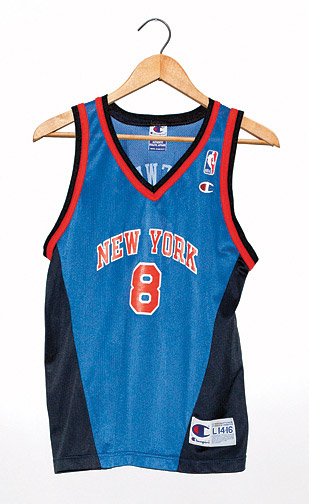
Latrell Sprewell was a centerpiece of the 1999 New York Knicks team that miraculously made a run to the NBA Finals. To me, he represented a paradigm of masculinity and a signature type of unjustified, ill-conceived, and immediate rage with which I, as a twenty-three-year-old Jewish kid from the Upper East Side, completely identified. In those days Sprewell would hurtle down the court with no plan whatsoever, then just take it to the hole or hoist up a shot that would make his coach cringe. And if that coach didn’t like it, Spree, as he was called, just might choke the motherfucker.
Spree would often take over games because he didn’t know any better. This almost willful ignorance, this incomparable ability to tune out the haters, put his head down, and just drive, actually kinda worked. The Knicks, who barely made the playoffs in 1999 with a 28–23 record, proceeded to become the first eighth-seeded team to get to the NBA Finals, blowing right by anyone who told them they weren’t good enough. It was around this time that I bought Spree’s number-eight Knicks jersey in the blue-and-orange away colors.
I got it at Gerry Cosby. It fit snug. And wearing it was an act of embracing my inner Spree: the guy who would defy you by hoisting up a thirty-foot jumper, or choke you for no apparent reason. I wasn’t very good at basketball—some might say I was awful—and I have long suffered from a debilitating neck injury that makes it difficult to run or jump. But I identified with Spree nonetheless.
I wore the jersey in my Brown thesis film, which I directed and in which I was also charged with the unfortunate duty of acting. I liked the finished product and I liked the way I looked in the Spree jersey, so I wore it on the first day of my next film in film school, and the next. It became something of a good luck charm, as well as a hidden mission statement. See, as I got older, any bluster Sprewell and I shared dissipated with each passing year. The notion that I would identify with a six-foot-five, cornrowed two-guard actually ended up seeming pretty ridiculous. But wearing this jersey signaled that it was still within me, somewhere. That if you pushed me far enough, I just might choke you out. Metaphorically.
The jersey was lucky until it wasn’t. I remember wearing it on one particularly ignominious professional occasion and cursing Spree as I slunk home in defeat, vowing never to wear it again. I guess the jersey’s luck had run out. The Knicks’ luck ran out, too. In 1999, when they finally arrived at the NBA Finals, the San Antonio Spurs defeated them in five games. The Spurs were bigger and better, and they made the Knicks look every bit the slightly above-average team we all feared they might be. They haven’t gotten anywhere close to the Finals since.
So I guess the whole “lucky item of clothing thing” is kinda silly. I liked this jersey because of the way it made me feel and because of what it represented, not because it had any magical powers. I’m sure Spree didn’t believe in luck. He didn’t believe in shit, except himself, even when he had absolutely no business believing in himself. And a lot of the time that worked. Maybe that’s what some mistake for luck. I don’t really know.
I do know that I never could bring myself to toss the Spree jersey. I still wear it, but most often when I’m doing laundry or when I have to dig particularly deep in my clothing rotation. And sometimes when I rock it—as I’m gingerly placing a dryer sheet atop a pile of dirty laundry in my Los Angeles apartment complex, so far from New York and from the person I was when I bought it—I remember that remarkable Knicks team. And for a fleeting moment, I feel like anything is possible.
Jonathan Levine is a film director and screenwriter whose films include Warm Bodies, 50/50, and The Wackness.
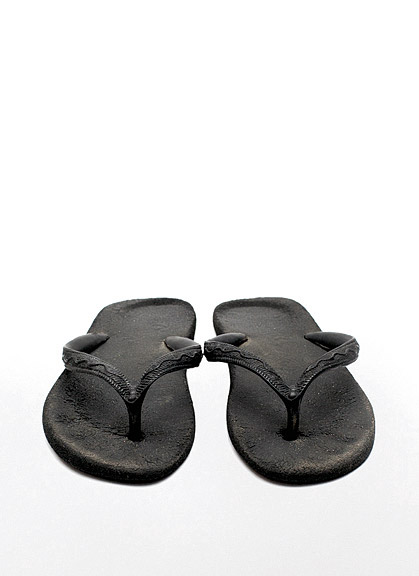
Like always, I was walking down Rehoboth Avenue with my grandmother. We went past Dolle’s Salt Water Taffy, Thrasher’s French Fries, Summer Winds T-shirt Shop, and the place where you could dress up in prairie costumes and get your sepia-toned photo taken—honky-tonk shops that line the main drag and lead to the boardwalk, stores I’d seen since I was wheeled down the avenue in a stroller.
The sun was bright and I wore conspicuously oversized sunglasses. I could feel the heat on my pink, freckled shoulders as I hobbled along on flip-flops that had just broken. It was my grandmother who insisted we stop into South Moon Under for a new pair. She perused the aisles, her bosom well contained beneath her grandma bathing suit and netted cover-up. “What about these?” she asked, gesturing with tanned, leathery arms at the pegs full of options: magenta, teal, polka-dotted, striped. Instead, I chose a simple black sturdy pair by Flojo, size eight. My grandmother paid, I slipped on the thongs—as my grandmother called them—and we were on our way. As we walked back to my family’s red umbrella on the beach, I could hear the Flojos flopping against the wooden boardwalk planks.
That was 1997 but I’m still wearing that pair of Flojos. And since then, flip-flop fashion has become ubiquitous. They’ve spread beyond the summer months, becoming acceptable footwear with suits and cocktail dresses as well as bathing suits and shorts. Expensive name brands have emerged, with bejeweled versions fetching four figures. Girls wear gold flip-flop charm necklaces. But for as long as I can remember, I’ve had exactly one simple pair.
“Who has flip-flops for sixteen years?” my sister, Lauren, asked on a recent family beach vacation. She told me she cycles through a couple pairs every year. They break, they wear out, they get left behind.
Mine didn’t. You could chalk up part of that time to a stylistic phase, several years long, during which I only wore boots and hulking, multi-inch platform shoes, the footwear component of a nun-like style. I liked being covered up year-round, even if it meant tights, twenty-hole lace-ups, and layers of crinoline under a full skirt in New York City’s thickest August humidity. During that stretch, I wouldn’t even consider wearing sandals, and my flip-flops emerged from my closet for very occasional pool or beachside use.
And yet, I kept them. Because I hang on to stuff. Like the rest of my belongings, these flip-flops have traveled with me from college to real life, from apartment to apartment, from Wilmington to Providence to New York to Philadelphia, and finally back to New York. I’ve got concert T-shirts from seventh grade, socks from summer camp, long flowing dresses from high school. I guess I find comfort in these things.
Through years of inadvertent preservation, these slip-ons have done some globetrotting. They’ve been in every hotel room where I wanted something between me and the grungy carpet; on every beach, from Fire Island to Fenwick Island, from Tulum to Turks and Caicos; in grimy hostel bathrooms on European backpacking trips. It’s like I find them waiting for me in my suitcase without realizing I’ve even packed them.
But mostly these Flojos wind up accompanying me on mundane activities, like sorting delicates at the laundromat, mailing the rent check, or stocking up on apple cider donuts at the farmers market. That’s how, over time, these flip-flops—plain, pulled from a rack without a thought, manufactured to be disposable but apparently indestructible—have become such a lasting fixture in my life. Precisely, perhaps, because they are so ordinary: you don’t even notice them casually accumulating the years, like the shops along Rehoboth Avenue, like grandmothers, like everything.
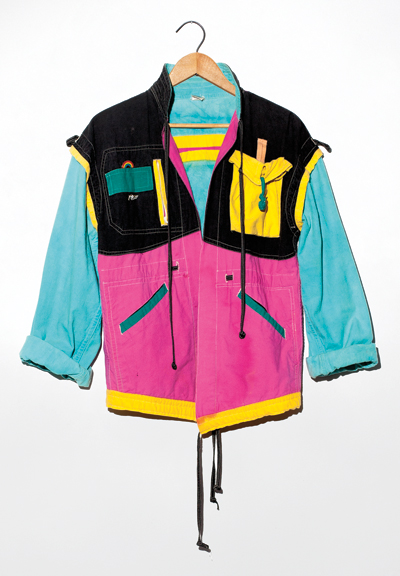
When I moved to Atlanta, I was looking for professional opportunities related to music. I ended up doing a lot of jingle singing and backup vocals. A friend I’d worked with in the 1970s who lived in Nashville called and told me that Roy Orbison’s backup soprano singer had been fired. They needed someone who could learn her parts quickly and who had a valid passport. “Any chance you’re available for the gig?” my friend asked.
My very first gig with Roy was in 1982 at a music festival in Bulgaria that was televised to over ten million people. It was rather intimidating, but thrilling. While Roy wasn’t in the limelight as he’d once been—in the 1960s The Beatles had opened for him!—he still had a sizable fan base around the world, especially in England and Australia. Shortly after the Bulgaria show, we went on a six-week tour in Australia. At the beginning of the trip, I bought a multicolored jacket with big shoulder pads, and it became my traveling jacket. For six weeks I wore a black jacket, black pants, and a sequined tube top onstage, but offstage I always wore this jacket.
Most of us rode around in a tour bus called “The Bitch.” It was then that I could see why people got into trouble on tour—it’s actually pretty boring unless you’re somewhere that’s exciting and you want to go sightseeing. Most people on tour didn’t feel like going out. Since I wanted to see the local sites, I mostly hung out with the guitar and bass players who wanted to explore as well. Maybe it was because we were hanging around together that they wound up with jackets like mine—not identical, but a similar style with wacky colors. We got into the habit of referring to the jackets as our “Arnotts,” like the Australian biscuit and snack company.. Jimmy Johnson, the bassist, recently reminded me that when we wore the jackets, we’d pretend we were aliens. We had some alien words: Arnott was one, Amso was another, and although the famously reclusive Roy didn’t have a jacket or participate, we dubbed him “Orbi 1 Con Orbi.”
Touring with Roy came to an end after an adventurous two years. I only wish, though, I’d left after Roy’s performance on Saturday Night Live.
—As told to Emily Spivack
Susan Bennett is a singer and voice-over artist who is most widely known for being the voice of the original U.S. version of Apple’s Siri.
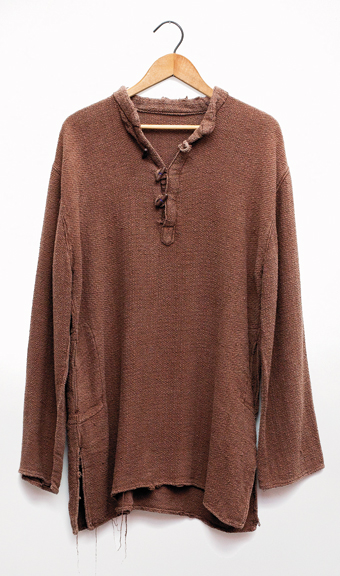
Shortly after I arrived in India, I made my way to the Maha Kumbh Mela, a Hindu gathering in Allahabad that happens once every 144 years when the planets align in such a way that they point to an intersection of the Ganges, the Yamuna, and Saraswati rivers. According to Hindu tradition, it’s believed that if you bathe in the rivers’ intersection at sunrise on that specific day, then you receive amrita—the nectar of immortality—and you’re freed from the cycle of life and death.
I was living with the Rainbow Gathering while I was at the Kumbh Mela. I had these wicked long dreadlocks and a hammock that I had made out of a piece of cloth and string. I ate free meals that the Hare Krishnas gave out. I had a crush on this girl who sang Hindu chants on the other side of the bonfire every night. Everyone was stroking each other with love and spiritual guidance, and it was just fucking beautiful.
I met this American journalist, Rob, and I found out that we were going on the same two-week silent meditation retreat. I’d admired his shirt, which he had custom made at a local tailor; I just thought it was dope. We hung out all afternoon and we bathed together at the intersection of the rivers at sundown. Afterward, he gave me his shirt. I’d been shirtless at the Maha Kumbh Mela, but after that, I wore it every day.
The meditation retreat at the Thai temple in Bodh Gaya was otherworldly, in-sync-with-the-cosmos-type shit. It was like being thrust into the professional level of a certain culture that I knew very little about, having skipped the minor leagues to get there. The lesson that came out of the retreat was rooted in Vipassana, the breath, and the ability to breathe through any experience; that becomes your shield.
After the retreat, I split off from Rob and made friends with an English-speaking rickshaw driver. I hung out with him for a couple days in Jaipur, and we established a rapport.
I had traveler’s checks and needed to exchange money. I knew I’d get a better rate on the black market, so I asked the rickshaw driver if he knew anyone. He took me to a little jewelry shop on a cobblestone street. The guys were friendly and they gave me a good rate. They asked if I’d like to go out with them that evening. I didn’t want to say no to an adventure. They told me I needed to clean myself up because they were taking me to a fancy place. They bought me a pair of shiny silver suit pants, shoes, and a belt. I wore the shirt that Rob had given me, tucked into the suit pants. I pulled back my dreadlocks.
That night was straight gangster cliché. We went to a nondescript building, through a cellar door, down stairs, and through a bustling, smoky kitchen. At the end of the kitchen, a door led to a strip club with really nasty looking strippers. Guys were making it rain rupees. We got hammered and afterward my rickshaw driver took me back to my hotel. It was super fun, so I hung out with them again the next night.
On the second night they said, “The reason we’ve been courting you is because we have a proposition.” They went on to explain that, in India, you’re only allowed to export a certain amount of jewelry each year to the U.S. without having to pay a tariff, but that on a U.S. passport, you could bring up to an additional $20,000 worth of purchased goods into the U.S. They asked if I would take jewelry back to the U.S., or mail it to myself and drop it off at a jeweler in New York City. I’d get $20,000 and they’d sell the jewelry for $90,000. I told them I wasn’t interested a number of times, but they urged me to call former backpackers who’d done it, a Brit and an American, who were very convincing. Eventually, I decided it was a no-risk situation, and while I wasn’t in a materialistic state of mind at that point, I thought I’d buy my mom the hot tub she’d always wanted.
Since I didn’t want to carry the jewels on my person I put them in a package and the guys took me to a post office, where I mailed them to my mom’s house in Massachusetts. As soon as I did that, things changed. I got picked up by two massive angry-looking dudes who didn’t speak English, in a car I’d never seen before. And they had my bag in the car! Since the rickshaw driver knew where I was staying, he had taken my bag from the hotel and signed me out. The two guys in the car said that their boss didn’t trust me and that I needed to fly with them to Mumbai to convince their boss that everything was okay. I told them I didn’t want to go, of course. Tensions were rising, and I was in a tough situation because they could have been armed. I reminded myself that I had this tool, the breath, Vipassana, an idealistic philosophy that I could breathe through it.
I finally relented, and we took a private plane to Bombay where we were picked up by a driver. I rode in a car with three guys who spoke no English for an hour and a half through the Bombay night. They took me to the penthouse of a crappy hotel where I wound up bunking with the two guys, who stayed in the room with me at all times. I wasn’t allowed to leave except to go to the hotel restaurant, where a few times a day the boss would show up and tell me I needed to put a $20,000 deposit on my credit card before they could let me go. He said his guys had been too trusting and had sent the jewels too soon. He wasn’t sure if I would rob them or actually take the jewels to New York.
I realized the irony of the situation. It was 180 degrees from staring across the bonfire at the dreadlock girl at the Rainbow Gathering on top of the hill, under the trees and stars, singing Hindu chants at Kumbh Mela.
On the third morning I snuck out of the hotel while the guys were still sleeping. I found a call center and called my credit card company. I spoke to two representatives who assured me that the credit card company would cover me on misrepresentation of merchandise because they personally approve each of their vendors across the world. I got off the phone thinking, “Fuck it. If the credit card company is willing to take the risk, I need to get the hell out of here.”
Since I didn’t have my own credit card at the time, they ran my mom’s credit card. She’d given it to me for emergencies only. Even though I have a high tolerance for risk, I figured I’d been kidnapped for three days, and that this was an emergency. I signed over the maximum on the card, $16,100.
And in no time, I was on a plane heading back to the States with all my stuff, still wearing the same shirt Rob had given me at the Kumbh Mela. They even paid for my ticket out of Bombay. I was sitting on the flight thinking that everything might be okay—they had just dropped a thousand dollars to fly me home, bought me clothes, put me up in a hotel, and were all smiles and hugs, reassuring me.
I got home and the jewels arrived on schedule. I immediately got them appraised. They were worth $2,500, not $20,000. And then my mom’s credit card was charged $16,100. When I called the credit card company, they said to look at the fine print. They would only cover misrepresentation within a one hundred mile radius of one’s billing address, never mind another hemisphere. At that point, I had to admit to my mom that I’d been scammed. All my pride in being able to survive anywhere, all the years traveling in Latin America, and all the spiritual highs of my semi-enlightened self in India came crashing down into a harsh reality.
I cut my dreadlocks off, bought a suit from Goodwill, and went to the local law library in the basement of a church in Northampton. I asked them to take me to the consumer protection section and I spent two weeks asking questions of paralegals, lawyers, and law librarians. One day when I came into the library, one of the law librarians was holding up a manila folder of printouts like it was the fucking Pelican Brief. She told me she’d found a relevant case that had been settled out of court.
That information was enough for me to get a pro bono attorney. My attorney put together a brief and sent it to the bank. The bank pushed back a couple of times with settlement offers, but we didn’t take any of them. The statute of limitations has now expired for the case, and although I have no idea what to do with them I still have the jewels.
I had a tremendously romantic affair with India before it broke my heart, but I’ve chosen to love it again. In fact, I’ve been back a few times. I have always sought the spirit I had during that trip; that’s part of the reason why I’ve held on to this shirt. Because I’d like to think I can still summon the total carpe diem, reckless abandon, bulletproof sense of invincibility that I once had wearing that shirt.
—As told to Emily Spivack
Jeff Zimbalist is a filmmaker whose films include Favela Rising, The Two Escobars, Youngstown Boys, Bollywood: The Greatest Love Story Ever Told, and Pelé—Birth of the Legend.
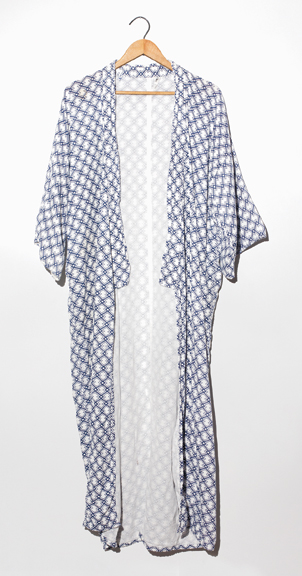
Bathrobes are transitional. You put them on temporarily, between waking and eating breakfast, showering and dressing, undressing and sleeping.
I’ve worn this bathrobe for the past ten years, during countless daily transitions and through major turning points in my adult life.
I started wearing it as a guest at my boyfriend’s apartment. He wanted me to feel comfortable, so he offered me a choice between two robes: this cotton, Kimono-style robe with a blue and white pattern and billowing sleeves or a tan one that’s monogrammed with his four initials. I wasn’t particularly drawn to either one, so I chose unmonogrammed because it seemed more neutral.
When we moved in together, the robe was unpacked and moved to my side of the closet. That’s when I started thinking of it as mine, and not a borrowed item.
I wore my robe less often after we got married. I guess my sense of modesty waned.
When I got pregnant, I wore it a lot. It was the only garment that comfortingly fit during my entire forty-two week pregnancy.
On summer nights I would put it on and turn sideways in front of our full-length mirror, feeling around for a bump. By late winter, after rejecting other clothes for being small, impractical, or uncomfortable, I would put on the bathrobe and lie down, bypassing the mirror altogether.
I brought the bathrobe to the hospital when I gave birth. I packed enough clothes to live there for a month, but the robe is the only thing I remember wearing. I can’t look at it now without flashing back to one particular hour of my twenty-six hour labor, when I put on the bathrobe and announced to my nurse Bianca, “We have to get out of here!” We left my husband, mother, and doula in birthing room two and crossed the hall to room five, which was empty and had a better view. There I began walking in circles around the room, which birthing books call “a spontaneous ritual,” an activity women come up with in the moment to deal with labor pain. I carefully timed each step so that my circle would last the length of a contraction. I remember starting each new circle by the window thinking, I just have to make it back to the window again....
I wore the robe so much during the first few months of my son’s life that I’m sure he thought it was my skin. He was at risk of jaundice when he was born, so I was advised to breastfeed him hourly. I didn’t have time to do anything but breastfeed and sleep, so instead of changing my clothes I just wore the robe around the clock, mostly unaware of whether it was day or night. I would pull open the bathrobe and nurse while my husband spoon-fed me chicken salad and fruit, trying not to spill any of it on our kid’s head.
Gradually my days and nights separated again, and now the bathrobe is my morning uniform. I pull it on at five o’clock in the morning when my son wakes up and he uses it as a communication system during the early morning hours before his first nap. He tugs on the hemline and looks at me pleadingly when he wants to be lifted up. He reaches for the robe at my knees when he wants me to help him walk. And he grabs it and rolls over onto his back when he’s feeling tired. I’d like to say that after I put him down to nap in his crib I disrobe, shower, and get dressed for the day, but usually I fall back into bed and wake up an hour later with the robe twisted around me.
Sabrina Gschwandtner is an artist living in Brooklyn.
Excerpted from Worn Stories by Emily Spivack, published last August by Princeton Architectural Press.
Photographs by Ally Lindsay

